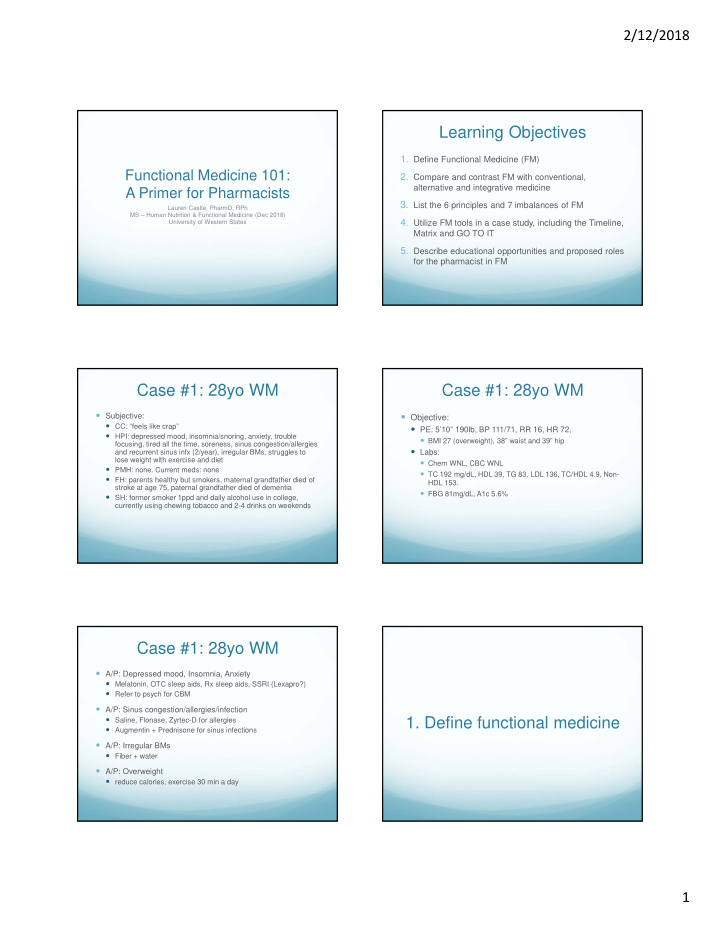



2/12/2018 Learning Objectives 1. Define Functional Medicine (FM) Functional Medicine 101: 2. Compare and contrast FM with conventional, alternative and integrative medicine A Primer for Pharmacists 3. List the 6 principles and 7 imbalances of FM Lauren Castle, PharmD, RPh MS – Human Nutrition & Functional Medicine (Dec 2018) 4. Utilize FM tools in a case study, including the Timeline, University of Western States Matrix and GO TO IT 5. Describe educational opportunities and proposed roles for the pharmacist in FM Case #1: 28yo WM Case #1: 28yo WM Subjective: Objective: CC: “feels like crap” PE: 5’10” 190lb, BP 111/71, RR 16, HR 72, HPI: depressed mood, insomnia/snoring, anxiety, trouble BMI 27 (overweight), 38” waist and 39” hip focusing, tired all the time, soreness, sinus congestion/allergies Labs: and recurrent sinus infx (2/year), irregular BMs, struggles to lose weight with exercise and diet Chem WNL, CBC WNL PMH: none. Current meds: none TC 192 mg/dL, HDL 39, TG 83, LDL 136, TC/HDL 4.9, Non- FH: parents healthy but smokers, maternal grandfather died of HDL 153. stroke at age 75, paternal grandfather died of dementia FBG 81mg/dL, A1c 5.6% SH: former smoker 1ppd and daily alcohol use in college, currently using chewing tobacco and 2-4 drinks on weekends Case #1: 28yo WM A/P: Depressed mood, Insomnia, Anxiety Melatonin, OTC sleep aids, Rx sleep aids, SSRI (Lexapro?) Refer to psych for CBM A/P: Sinus congestion/allergies/infection Saline, Flonase, Zyrtec-D for allergies 1. Define functional medicine Augmentin + Prednisone for sinus infections A/P: Irregular BMs Fiber + water A/P: Overweight reduce calories, exercise 30 min a day 1
2/12/2018 Modern Day FM A New Approach Chronic Disease & Morbidity Jeffrey Bland, PhD, FACN, Mark Hyman, MD CNS • IFM Chairman Health • Director of the Cleveland Clinic • Father of FM Center for FM, 2014 • IFM Founder, 1991 & Economy Definition Functional Medicine is a systems-biology-based model that empowers patients and practitioners to work together to achieve the highest expression of health by addressing the underlying causes of disease. Functional Medicine uses a unique operating system and personalized therapeutic interventions to support individuals in achieving optimal wellness. 2. Compare and contrast the acute care model vs chronic care model 2
2/12/2018 Current model: Acute Care Pharmaceutical Evolution Rapidly identify and treat emergent problems Works well in emergency/hospital settings Relies on deductive reasoning and “reductionism” Historically developed for Infectious disease The “Silver bullet”: antibiotics Physiologic Receptor Antibiotics “Name it and blame it” Antagonists Modulators “A drug for each bug” “A pill for each ill” FM: We must find the root cause of this broken bone! Functional vs. Conventional Influences on Chronic Disease http://www.ibsgroup.org/other/articles/Understanding_functional_medicine.pdf Functional vs. Conventional Conventional Complementary All Functional Medicine is Integrative, Alternative but not all Integrative Medicine is Functional Integrative Medicine: healing-oriented, body/mind/spirit, lifestyle approach that combined Conventional and CAM therapies X Functional Medicine: emphasizes underlying cause of dysfunction, organizes assessment & treatment using FM tools http://www.ibsgroup.org/other/articles/Understanding_functional_medicine.pdf 3
2/12/2018 Seven Core Imbalances Assimilation: • digestion, absorption, microbiota/GI, respiration Defense and repair: • immune, inflammation, infection/microbiota Energy: • energy regulation, mitochondrial function 3. FM by the Numbers Biotransformation and • toxicity, detoxification 7, 6, 5, 4, 3, 2, 1 elimination: Transport: • cardiovascular and lymphatic systems Communication: • endocrine, neurotransmitters, immune messengers Structural integrity: • subcellular membranes to musculoskeletal integrity Six Principles of FM 5R/4R Protocol Biochemical Individuality Pathogens, food sensitivities, PPI Remove Promotion of Patient-Centered Organ Reserve Vitamins, minerals, enzymes, gastric Replace acid, fatty acids, calories, antioxidants Probiotics, prebiotics, synbiotics Reinoculate Dynamic Health as a Balance of Mind, Positive Vitality Body, & Spirit Repair L-glutamine, anti-inflammatory therapy Web-like Interconnections Rebalance Stress and lifestyle issues Four P’s of FM 5 Causes of Environmental Illness 1. Toxins Personalized Predictive • biologic, elemental, synthetic • Genetic and environmental • Tailored health strategy variations drive and define based on personalized map individual treatment of health risks with 2. Allergens traditional and novel biomarkers • food, mold, dust, animal products, pollens, chemicals 3. Microbes Preventative Participatory • bacteria, yeast, viruses, parasites, worms • Proactive vs. reactive • Empowers and engages the approaches that shift focus patient 4. Stress from illness to wellness, from disease treatment to • physical or psychological functional enhancement 5. Poor diet • standard American diet, or SAD 4
2/12/2018 Two questions “Three Legs of the Stool” Approach Fill an unmet Get rid of need? something? • Nutrients • Toxins • Air • Allergens • Water • Microbes • Sleep • Poor diet • Connection • Stress The FM Tree 4. Understand how to use FM tools in a case The Timeline, the Matrix, and GO-TO-IT 5
2/12/2018 The Timeline Use the Timeline to put together an extensive lifetime picture where clinical patterns emerge: Ages, events, symptoms, diagnoses Triggering events ATMs: antecedents, triggers, mediators Significant contributory lifestyle factors Matrix Collect and organize patient’s history, lifestyle, S&S S&S classified as clinical imbalances in seven core physiological systems that transcend organ boundaries Assimilation Defense and repair Transport Communication Structural integrity Biotransformation and elimination Energy GO TO IT Gather Gather • Gather information from the patient Purpose IFM Tools (examples) GATHER ONESELF: Mindful Meditation Organize • Organize patient history on the matrix and timeline Mindfulness; optimizing the Health History and Intake Forms therapeutic relationship Tell • Tell the story back to the patient Medical Symptom Questionnaire GATHER INFORMATION through intake forms, Timeline • Order and prioritize treatment strategies Order questionnaires, the initial Chronological Story consultation, physical exam, and objective data. A detailed ATMs and the Patient’s Story • Initiate further assessment and treatment Initiate functional medicine history ABCDs of Nutritional Evaluation taken appropriate to age, Request and Report gender, and nature of • Track progress Nutrition Physical Exam Forms Track presenting problems. 6
Recommend
More recommend